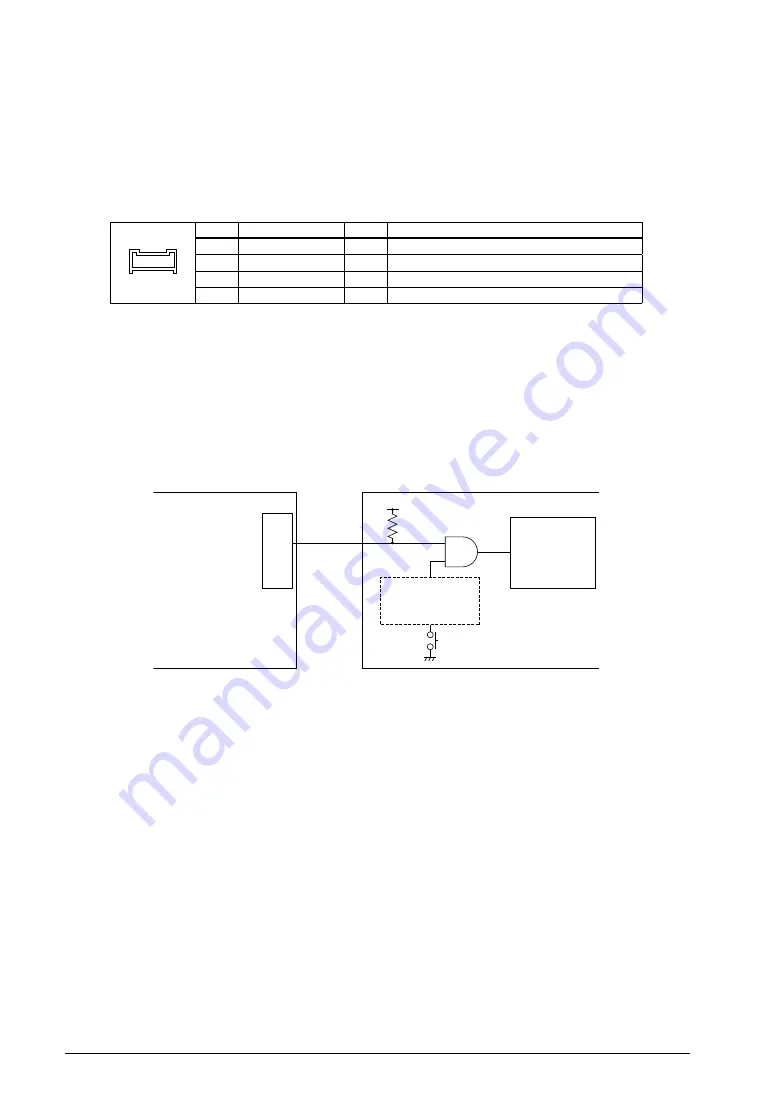
4 Connections
10
Seiko Epson Corporation
S5U1C17001H USER MANUAL
(ICDMINI VER1.0 and VER1.1)
4.1.2 Flash Programming Power Supply Connector
The 4-pin Flash programming power supply connector (white) is used to output a reset signal and a Flash
programming voltage to the target system, and to input the target interface voltage. These signals are not necessary
for debugging. Connect between this connector and the target system using the Flash programming power supply
cable attached to the S5U1C17001H as necessary. The pin assignment of the 4-pin connector (white) on the
S5U1C17001H is shown in the table below.
Table 4.1.2.1 Pin Assignment of the Flash Programming Power Supply Connector (White)
No.
Pin name
I/O
Pin function
• • • •
4
3
2
1
1
FLASH VCC OUT
O
Flash programming voltage output pin
2
GND
–
Power supply GND pin
3
TARGET RST OUT
O
Target reset signal output pin
4
TARGET VCC IN
I
Target voltage input pin
*
Pay attention to the pin number assignment. (It is the reverse order of the target interface connector.)
Target reset signal output (TARGET RST OUT)
By pressing the RESET/START switch in ICD mode, the TARGET RST OUT outputs a reset signal to the
target system.
When using the TARGET RST OUT output, a reset circuit as shown in the figure below is recommended.
The connection to #RESET of target reset signal is not essential, although it allows debugging to be performed
more efficiently. When using the Flash protection function, it is best to have a connection. Connection is also
recommended in the Flash programmer mode and when using the S5U1C17001H as the Gang Writer (Gang
Programmer) using S5U1C17000Y2.
S5U1C17001H
TARGET RST OUT
Target system
S1C processor
Pull-up resistor
Reset switch
Reset circuit on
the target system
#RESET
4
3
2
1
Figure 4.1.2.1 Example of Target Reset Circuit
Target voltage input (TARGET VCC IN)
In addition to 3.3 V and 1.8 V, the S5U1C17001H is capable of interfacing with the target system using the
voltage (Ver1.0 : 1.0 to 5.0V, Ver1.1 : 1.0 to 5.5V) input from the target system. To use this function, set SW4 to
ON and input the target voltage to the TARGET VCC IN pin.
Flash programming voltage output (FLASH VCC OUT)
Depending on the Flash memory module built into the S1C processor on the target system, its programming
voltage (7V) can be supplied from the S5U1C17001H. The maximum current that can be supplied is 30mA.
To use this output, set SW8 to ON and connect between the FLASH VCC OUT pin and the power supply pin
on the target system. This mode functions only in Flash Writer mode. When SW8 is set to ON, the FLASH
VCC OUT pin always outputs a 7-V voltage regardless of whether the RESET/START switch is pressed or not.
Note: Refer to the technical manual of each model as to whether the target S1C processor is operable
with this voltage or not. Do not use this voltage unless there is a description about the usage in
the technical manual, as the S1C processor may be destroyed due to overvoltage.
















































